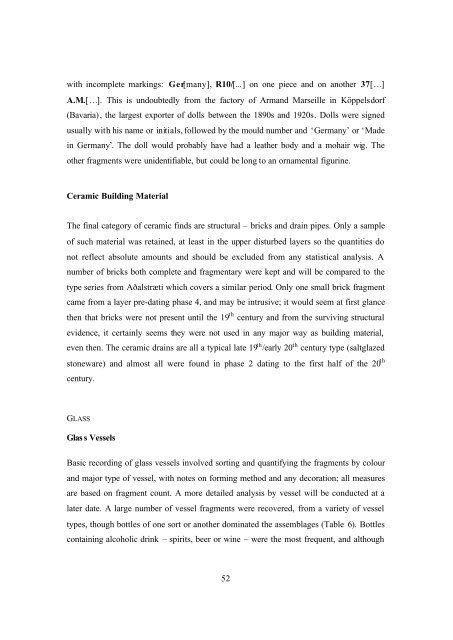Skáholt 2002 - Nabo
Skáholt 2002 - Nabo
Skáholt 2002 - Nabo
Create successful ePaper yourself
Turn your PDF publications into a flip-book with our unique Google optimized e-Paper software.
with incomplete markings: Ger[many], R10/[...] on one piece and on another 37[…]<br />
A.M.[…]. This is undoubtedly from the factory of Armand Marseille in Köppelsdorf<br />
(Bavaria), the largest exporter of dolls between the 1890s and 1920s. Dolls were signed<br />
usually with his name or initials, followed by the mould number and ‘Germany’ or ‘Made<br />
in Germany’. The doll would probably have had a leather body and a mohair wig. The<br />
other fragments were unidentifiable, but could be long to an ornamental figurine.<br />
Ceramic Building Material<br />
The final category of ceramic finds are structural – bricks and drain pipes. Only a sample<br />
of such material was retained, at least in the upper disturbed layers so the quantities do<br />
not reflect absolute amounts and should be excluded from any statistical analysis. A<br />
number of bricks both complete and fragmentary were kept and will be compared to the<br />
type series from Aðalstræti which covers a similar period. Only one small brick fragment<br />
came from a layer pre-dating phase 4, and may be intrusive; it would seem at first glance<br />
then that bricks were not present until the 19 th century and from the surviving structural<br />
evidence, it certainly seems they were not used in any major way as building material,<br />
even then. The ceramic drains are all a typical late 19 th /early 20 th century type (saltglazed<br />
stoneware) and almost all were found in phase 2 dating to the first half of the 20 th<br />
century.<br />
GLASS<br />
Glas s Vessels<br />
Basic recording of glass vessels involved sorting and quantifying the fragments by colour<br />
and major type of vessel, with notes on forming method and any decoration; all measures<br />
are based on fragment count. A more detailed analysis by vessel will be conducted at a<br />
later date. A large number of vessel fragments were recovered, from a variety of vessel<br />
types, though bottles of one sort or another dominated the assemblages (Table 6). Bottles<br />
containing alcoholic drink – spirits, beer or wine – were the most frequent, and although<br />
52
















